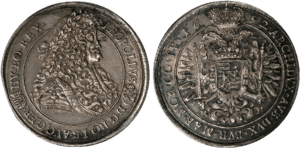Thaler
A thaler (/ˈtɑːlər/) is one of the large silver coins minted in the states and territories of the Holy Roman Empire and the Habsburg monarchy during the Early Modern period. A thaler size silver coin has a diameter of about 40 mm and a weight of about 25 to 30 grams, or roughly 1 ounce.
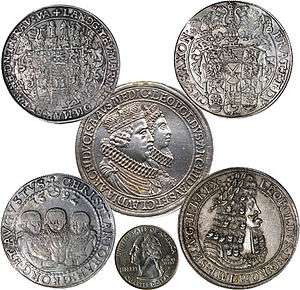
The word is shortened from Joachimsthaler, the original thaler coin minted in Joachimstal, Bohemia, from 1518. After the collapse of the Holy Roman Empire, the German Reichstaler survived in the form of the Prussian thaler (later Vereinsthaler) until 1871.
The thaler silver coin type continued to be minted as legal tender of modern currencies, such as the US silver dollar (until 1935) and the Swiss 5 francs coin (until 1928). Copies of the (Austrian) Maria Theresia thaler were made by various government mints until the 1960s. Many government mints continue to issue thaler sized silver coins with face values in national currency, now known as bullion coins, as their silver value significantly exceeds the face value.
The English form of the name, dollar, survives as the name of a number of modern currencies. Also from the name of the thaler is the Samoan currency name tālā and (until 2007) the Slovenian tolar.
Etymology
German taler is recorded from the 1530s, as an abbreviation of Joachimstaler. The silver mines at Joachimstal had opened in 1516, and the first such coins were minted there in 1518. The original spelling was taler (so Alberus 1540). German -taler means "of the valley" (c.f. Neanderthaler). By the late 16th century, the word was variously spelled as German taler, toler, thaler, thaller; Low German daler, dahler. In 18th to 19th-century German orthography, Thaler became standard, changed to Taler in the 1902 spelling reform.
The name taler, thaler was soon used in compounds denoting various types of silver coins of thaler size, thus Reichstaler (1566), Silbertaler, Albertustaler (1612), Laubthaler (1726), Kronenthaler (1755), Ortsthaler, Schützentaler, Conventionsthaler (1754), Bankthaler, Spesciesthaler (etc.). The Dutch daalders also carried the picture of a lion, which gave them the name leeuwendaalder ("lion thaler", 1575). From 1750, German Taler, Thaler predominantly refers to the Prussian Reichsthaler (1750–1857), after 1857 the Vereinsthaler (in 1871 replaced by the Mark).
The corresponding English silver coin of the period was the crown. The Low German word was adopted in English as daler by 1550, modified to dollar by about 1600. [1] English thaler was introduced in the first half of the 19th century to refer to the coins of the German states, as the word dollar was increasingly understood to refer to the United States dollar.
Predecessors
The development of large silver coins is an innovation of the beginning Early Modern period. The largest medieval silver coins were known as groat (German Groschen), from denarius grossus or "thick penny". These rarely exceeded a weight of 6 grams. In the late 15th century, even these coins were increasingly debased, as a general silver shortage developed in Europe for a number of reasons, induced by the costs of continual warfare, and by the incessant centuries-long loss of silver and gold in indirect one-sided trades importing spices, porcelain, silk and other fine cloths and exotic goods from India, Indonesia and the Far East. This continual debasement had reached a point that silver content in Groschen-type coins had dropped, in some cases, to less than five percent, making the coins of much less individual value than they had in the beginning.
This trend was inverted with the discovery of new and substantial silver deposits in Europe beginning in about the 1470s. Italy began the first tentative steps toward a large silver coinage with the introduction in 1472 of the lira tron in excess of 6 grams (3 7⁄8 dwt), a substantial increase over the roughly 4-gram (2 5⁄8 dwt) gros tournois of France. In 1474 a 9-gram (5 3⁄4 dwt) lira was issued but it was in 1484 that Archduke Sigismund of Tirol issued the first truly revolutionary silver coin, the half Guldengroschen of roughly 15.5 grams (10 dwt). This was a very rare coin, almost a trial piece, but it did circulate so successfully that demand could not be met.
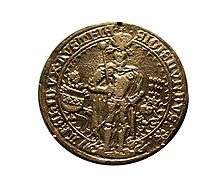
Finally, with the silver deposits—being mined at Schwaz—to work with and his mint at Hall, Sigismund issued, in 1486, large numbers of the first true thaler-sized coin, the Guldengroschen ("gold-groat", being of silver but equal in value to a Goldgulden).
The Guldengroschen, nicknamed the guldiner, was an instant and unqualified success. Soon it was being copied widely by many states who had the necessary silver. The engravers, no less affected by the Renaissance than were other artists, began creating intricate and elaborate designs featuring the heraldic arms and standards of the minting state as well as brutally realistic, sometimes unflattering, depictions of the ruler (monarch).
Joachimsthaler
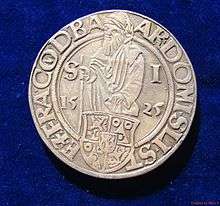
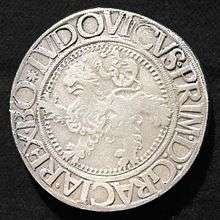
By 1518, guldiners were popping up everywhere in central Europe. In the Kingdom of Bohemia, then ruled together with Hungary by Louis II of the Jagiellonian dynasty, a guldiner was minted— of similar physical size but slightly less fineness—that was named in German the Joachimsthaler, from the silver mined by the Counts of Schlick at a rich source near Joachimsthal (St. Joachim's Valley, Jáchymov – now in the Czech Republic) where Thal (Tal) means "valley" in German. Joachim, the father of the Virgin Mary, was portrayed on the coin along with the Bohemian lion. Similar coins began to be minted in neighbouring valleys rich in silver deposits, each named after the particular 'thal' or valley from which the silver was extracted. There were soon so many of them that these silver coins began to be known more widely as 'thaler' in German and 'tolar' in the Czech language.
From these earliest 'thaler' developed the new thaler – the coin that the Holy Roman Empire had been looking to create as a standard for trade between the regions of Europe. The original Joachimsthaler Guldengroschen was one ounce in weight (27.2 g). The Empire's Reichstaler (1566 to 1750) was defined as containing 400.99 grains of silver (equal to 25.984 g) and became the coin of account of the whole Empire.
In the 17th century, some Joachimsthalers were in circulation in the Tsardom of Russia, where they were called yefimok (ефимок) – a distortion of the name Joachim.
Holy Roman Empire
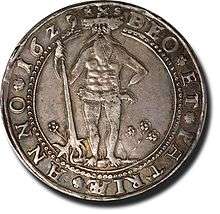
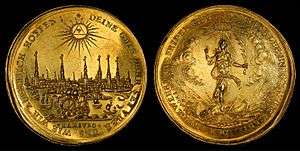
The new large silver coins that became ubiquitous as the 16th century went on were named thaler in German, while in England and France, they were named crown and écu, respectively, both names taken from what had originally been gold coins. The thaler size silver coins minted in Habsburg Spain was the eight real coin, later also known as peso and in English as "Spanish dollar".
The "city view" thalers of the 17th and 18th century have predecessors in stylised representations of cities (as three towers, or a city gate) on the obverse of thaler coins in the late 16th century, such as the Lüneburg thaler of Rudolf II made in 1584. More elaborate city views become current in the first half of the 17th century (e.g. Augsburg 1627, Nürnberg 1631). The type continues to be popular throughout the 18th century, culminating in detailed city panoramas rendered in one-point perspective.
In the late 16th and 17th centuries, there was a fashion of oversized thaler coins, the so-called "multiple thalers", often called Löser in Germany. The first were minted in Duchy of Brunswick-Luneburg, and indeed the majority were struck there. Some of these coins reached colossal size, as much as sixteen normal thalers, exceeding a full poud (over 450 g) of silver and being over 12 cm (5 in) in diameter. The name Löser most likely was derived from a large gold coin minted in Hamburg called the portugalöser, worth 10 ducats, which were based on Portuguese 10-ducat coins.[2] Eventually the term was applied to numerous similar coins worth more than a single thaler. These coins are very rare and highly sought after by collectors. As few of them were circulated in any real sense, they often remain in well-preserved condition.
In the Holy Roman Empire, the thaler was used as the standard against which the various states' currencies could be valued. One standard also adopted by Prussia was the Reichsthaler, which contained 1⁄14 of a Cologne mark of silver. In 1754, the Conventionsthaler was introduced, containing 1⁄10 of a Cologne mark of silver.
Dutch Republic
The Dutch rijksdaalder was first issued by the Republic of the Seven United Netherlands in 1575/6, during the Dutch Revolt. Featuring an armored half bust of William the Silent, rijksdaalder was minted to the Saxon reichsthaler weight standard. Friesland, Gelderland, Holland, Kampen, Overijssel, Utrecht, West Friesland, Zeeland, and Zwolle minted armored half bust rijksdaalders until the end of the 17th century. This coin replaced the older kruisdaalder, depicting the Cross of Burgundy, now depicting the Belgic Lion, hence its Dutch name leeuwendaalder ("lion thaler").
The leeuwendaalder was authorized to contain 427.16 grains of .750 fine silver and passed locally for between 32 (at introduction in 1576) to 42 stuivers (the stuiver containing less silver over time). It was lighter than the large denomination coins then in circulation, namely the ducatoon (491 grains of .920 fine silver and passing at 3 guilders or 60 stuivers) and the rijksdaalder (448 grains of .885 fine silver passing at 2½ guilders or 50 stuivers). The leeuwendaalder became the coin of choice for foreign trade and was popular in the Middle East, the colonies in the east and in the west.
The Dutch leeuwendaalder was imitated in several German and Italian cities. These coins circulated in Romania and gave their name to the currencies of Romania and Moldova, the leu, and of Bulgaria, the leva.[3]
Production stopped after the introduction of the new silver coinage based on the gulden by Holland in 1680. This also contained a half 3 gulden of 30 stuiver, which remained to be called Daalder in common speech.
From New Netherland (New York) the leeuwendaalder spread to all Thirteen Colonies and became the namesake of the American dollar.[4][5]
Old Swiss Confederacy
The Thirteen Cantons of the Old Swiss Confederacy and their Associates each minted their own coins. Thaler and half thaler coins were minted by the cities of Zürich (1512), Bern, Lucerne, Zug, Basel, Fribourg, Solothurn, Schaffhausen, St. Gallen and Geneva.
The Reformed cities began to represent "city views" on the obverse of their thalers, as they did not have the option to represent either patron saint or ruling princes. The first city view thaler of Zürich was minted in 1651 (the so-called Vögelitaler).[6]
These currencies were abolished in 1798, with the introduction of the franc of the Helvetic Republic. The cantons resumed minting their own coins from 1806, now mostly denominated in francs, with one Swiss franc equal to 1.5 French francs. Thaler size coins (in some instances named Neutaler, Nüw-Taler) were now denominated as 4 francs, or 40 batzen; the first two Schützentaler, minted by Graubünden and Glarus in 1842 and 1847, respectively, had this denomination.
Cantonal currencies were again abolished with the introduction of the modern Swiss franc in 1850, with an official exchange rate of 7 to 10 (seven batzen to one new franc). The new 5 francs coin while valued at 35 batzen, worth slightly less than the old thalers, was nevertheless dubbed Taler or Franken-Taler in some regions of Switzerland. The Bernese diminutive Täli was recorded for the 1 franc coin in the early 20th century.[7]
Scandinavia
The name thaler was introduced to Scandinavia as daler. The first Swedish daler coins were minted in 1534. The Norwegian speciedaler was minted from 1560. Later Scandinavian daler coins included the Swedish riksdaler (1604) and the Danish rigsdaler (1625). In the early 19th century, these countries introduced their modern currency based on the daler unit. In Norway, speciedaler was chosen as the currency name in 1816.
These currencies in Denmark and Sweden were replaced by the Danish krone and Swedish krona in 1873, the new currencies introduced by the Scandinavian Monetary Union. Norway joined the Monetary Union and introduced the Norwegian krone in 1876.
19th-century Germany
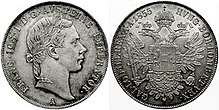
In 1837, the Prussian thaler became part of a currency union which set the value of the southern German gulden at 1 3⁄4 per thaler. By 1850, nearly all German states used this standard of Thaler, though with differing subdivisions.
In 1857, the Vereinsthaler was adopted by most German states as well as in the Habsburg Empire. Vereinsthalers were issued until 1871 in Germany and 1867 in Austria. Within the new German Empire, vereinsthaler coins circulated as 3-mark pieces until 1908 when they were withdrawn and demonetized. Some old countermarked thalers circulated as emergency coinage in Germany during the inflationary period following its defeat in the First World War.
The Maria Theresa thaler, minted from 1741, enjoyed a special role as trade currency and continued to be minted long after the death of Maria Theresa in 1780, with coins minted after her death always showing the year 1780. Francis Joseph of Austria declared it an official trade coinage in 1857, and it lost its status as legal tender in Austria in 1858. The Maria Theresa taler became the de-facto currency of the Ethiopian Empire in the late 18th century, and in continued to be in use into the 20th century in the Horn of Africa, Eastern Africa, India and throughout much of the Arabian Peninsula.
Legacy
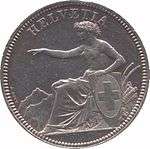
The Latin Monetary Union of 1865–1927 attempted to standardise European silver coins, introducing a debasement from 90% to 83.5% silver because rising silver prices had led to the face value of silver coins being exceeded by the metal value. The thaler size silver coin of the French franc was the 5-francs coin, also known as écu, which was last minted in 1879. The United States continued to mint silver dollar coins until the 1930s, and the Swiss 5 francs coin, originally based on the French 5 francs coin, continued to be minted in silver until 1969, albeit reduced in silver content (from 25 g at 90% to 15 g at 83.5%) after 1928.
Silver commemorative coins in thaler size, not intended for circulation as regular currency, became popular in the 17th to 18th centuries. Notable examples include the Gluckhennentaler of Basel (1645) and the Luftpumpentaler of 1702 (commemorating the Magdeburg hemispheres experiment). Münzbesuchstaler are thaler coins minted to commemorate a visit to the mint by the regent, a German tradition beginning in the 1850s. Some modern silver commemorative coins minted in German-speaking Europe are given the name Taler, such as Swiss Schützentaler, the Swiss Helvetia-Taler minted in yearly intervals since 1992, the Austrian Haller-Taler of 1986.
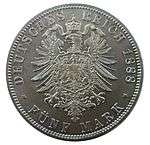
The German Vereinsthaler was abolished in 1871, with the introduction of the German gold mark, with the exchange rate of 3 Mark to one Taler. The 3 Mark coin, at 15 g silver, was colloquially called Taler. The old Vereinsthaler, minted before 1871, remained legal tender with the value of 3 Mark until 1908 (even though they were closer to 5 Mark coins in silver content). In Greece, the term taliro (τάληρο) is commonly used for the denomination of five of the local currency (5 drachmae or 5 euros). This reflects the fact that, when introduced in 1833, the new Greek currency, the drachma, corresponded to 1⁄5 of the value of one thaler, the latter coin thus being equivalent to the 5-drachma coin. The term is still used for the 5-euro banknote.
Use of the Maria Theresia thaler as the de-facto currency of Ethiopia survived into the 1930s. It has been estimated that more than 20% of the 245 million pieces minted until 1931 ended up in Ethiopia.[8] In 1890, the Italians introduced the Tallero Eritreo, styled after the Maria Theresia thaler, for Italian Eritrea.[9] In the early 1900s Menelik II unsuccessfully attempted to mint "Menilek thalers" locally, with his effigy, but styled following the model of the Maria Theresia thaler, and force their use. Starting in 1935 the Italians minted the Maria Theresia thaler at the mint in Rome for use in their conquest of Ethiopia. Then during World War II, the British minted some 18 million Maria Theresia thalers in Bombay to use in their campaign to drive the Italians out of Ethiopia.[10]
Bullion coins are coins minted by national mints which are nominally legal tender but not intended for normal circulation, with a face value that harks back to the currency values of the early 20th century. Silver bullion coins are often minted at one ounce and thus roughly of thaler size. The first such bullion coin was the Mexican onza of 1949. Another example is the American Silver Eagle of 1986, minted to the specifications of a pre-1935 silver dollar coin.
Unrelated to specific coins, the name of the thaler survives in various modern currency names, in the form dollar in twenty-three currencies used in countries including Australia, Canada, Hong Kong, New Zealand and the United States of America, and in the Slovenian form tolar until 2006. In 2017 a cryptocurrency named Taler was launched in Belarus as a legal payment instrument.[11]
Chronology of thaler development


- 1486: Sigismund of Tirol issues his 31.93 g Guldengroschen of 60 Kreuzers and .9375 fineness.
- 1493: Switzerland issues its first Guldengroschen at Bern
- 1499: Hungary issues the first Guldiner/Guldengroschen. It is the earliest year of issue with Arabic numerals on the coins in Hungary.
- 1500: The first German Guldengroschen is issued from Saxony, with a value of 24 Groschen. In Bremen it circulates equivalent to 36 Groten. These Guldengroschen are reduced in weight to 29.2 g so as to be minted at eight coins to the Cologne mark.
- 1518: The first coin actually called a "Thaler" is minted in Joachimsthal, Bohemia, Holy Roman Empire. Its weight is as the standard of 1500.
- 1524: In an attempt to standardise the guldiner, a money ordinance (Reichsmünzordnung) is issued at Esslingen, Germany reaffirming the fineness of the coin at 937.5, and its weight to 29.2 g.
- 1534: Saxony and Bohemia alter the fineness of their guldiners down from .9375 purity to .903 while maintaining the same coin weight, thus lowering the actual amount of pure silver in the coin. This begins a separation of the Thaler from its guldiner ancestry.
- 1551: A new money ordinance is decreed in Augsburg that lowers the guldiner's purity to .882, but raises the weight of the coin to 31.18 g. This returns the coin to being the equal value of a Goldgulden. The Thaler is now equivalent to 72 Kreuzer.
- 1559: After the death of the Holy Roman Emperor Charles V, yet another money ordinance is decreed at Augsburg, this time radically altering the coin (now to be called a Reichsguldiner) down to a mass of just 24.62 g, but returning the coin to .931 fineness. This sets the Guldiner to be equivalent to 60 Kreuzer once again.
- 1566: The guldiner as a denomination is more or less eliminated by a Saxon money edict that establishes the Reichsthaler (known later as the Speciesthaler) with a fineness of 889.0 and a weight of 29.2 g.
- 1667: An agreement made at the Abbey of Zinna between Saxony, Brandenburg, and Brunswick-Lüneburg to help make the minting of small coins more economical than could be done under the old Augsburg ordinances led to the Thaler being reduced in weight to 28.1 g but retaining the same .889 fineness.
- 1690: The Leipzig Money Convention met to deal with the poor quality of coinage in Saxony, Brandenburg, and Brunswick. The agreement of 1667 had not solved the problem so the thaler was again reduced in weight down to 25.9 g. At this point 12 Thaler are being minted to provide one Cologne mark of silver, up from nine in 1500.
- 1750: This year saw yet another reduction in weight in the areas controlled by Prussia, Hesse, and Brunswick-Wolfenbüttel down to just 22.2 g and a .750 fineness. 14 thalers are minted to contain one Cologne mark of silver.
- 1754: The monetary agreement between Austria and Bavaria in 1753 began the period of the Conventionsthaler, a thaler set at 10 to equal one Cologne Mark of silver. Its weight was 28.0 g with a fineness of .833. Over time this coin spread into a large portion of central and southern Germany.
- 1755: The Kronenthaler (a thaler with 3 or 4 crowns between the Burgundy cross) is first issued in areas controlled by the Habsburgs, especially in the Austrian Netherlands (present-day Belgium) and southern Germany. It had a weight of 29.44 g and a fineness of .873.
- 1857: The Vienna monetary contract finally eliminates the Cologne Mark as a standard against which the silver coinage of Austria and Germany are reckoned, replacing it with a simple tariff of 500 g. Thirty Vereinsthalers are set to be minted from this 500 g standard. The coins weighed 18.5 g and had a .900 fineness. They are set to equal 90 Austrian Kreuzer, 105 Bavarian Kreuzer, 30 Groschen, or 48 Schilling depending on the minting region.
- 1872: The last thalers are minted in a few states, notably Saxony.
- 1908: The last circulating thalers were withdrawn and demonetised in Germany.
References
- Christian Ludwig, Teutsch-Englisches Lexicon (1789), c.448 gives dollar, doller as the English translation of Thaler.
- Gold medallic portugalöser (10 ducats)
- "Online Etymology Dictionary". www.etymonline.com.
- "Production of the Leeuwendaalder". www.coins.nd.edu.
- "Lion Dollar – Introduction". www.coins.nd.edu.
- Künker Auktion 316, Numismatischer Verlag Künker (2019), 282.
- Schweizerisches Idiotikon s.v. Taler II 12,1350–1392.
- Kalmer, Joseph; Hyun L. (1935). Abessinien (in German and Czech). Translated by Milena Jesenská.
Chapter 13 describes currencies used in pre-WWII Abyssinia.
- "Eritrean Tallero". 30 May 2008. Archived from the original on 28 August 2015.
- Tschoegl, Adrian E (2001). "Maria Theresa's Thaler: A Case of International Money". Eastern Economic Journal. 27 (4): 445–464.
- "Биткоин по-мински: зачем Белоруссия разработала национальную криптовалюту". RT на русском.
Books
- Duve, Gebhard (1966). HISTORY OF THE REDEEMABLE, MULTIPLE AND MINING TALERS OF BRUNSWICK-LUNEBERG. Johannseburg: Duve.
External links

